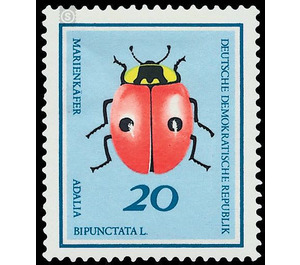Useful beetles - Germany / German Democratic Republic 1968 - 20 Pfennig
Theme: Animals
| Country | Germany / German Democratic Republic |
| Issue Date | 1968 |
| Face Value | 20.00 |
| Color | blue |
| Perforation | K 13 1/2: 13 |
| Printing Type | offset |
| Stamp Type | Postage stamp |
| Item Type | Stamp |
| Chronological Issue Number | 1155 |
| Chronological Chapter | GER-DDR |
| SID | 570713 |
| In 24 Wishlists | |
Useful Beetles The Ministry of Posts and Telecommunications of the German Democratic Republic issues six multicolored special postal stamps with pictures of useful beetles. Useful beetles The total number of beetles living in Central Europe is difficult to specify; Sure, there are a few hundred species. The difficulty arises not least from the fact that the concept of usefulness is difficult to define. There are many beetles that play an important role in the household of nature and are therefore indirectly useful. Many Silphidae (carrion beetles) eliminate animal carcasses, the dung beetles bring feces under the ground, Georyssidae and Heteroceridae eliminate organic sludge at pond and stream edges. These are very important and useful activities. This circumstance should not be forgotten when talking about beneficial beetles, because in general one thinks first of all of beetle species that play an important role in the natural control of pests of agriculture or the forest. Many ground beetles (Carabidae) eat the terrestrial pests living on and in the soil, many short - winged (Staphylinidae) and long - tailed beetles (Histeridae) kill fly larvae, not a few beetles (Nitidulidae), flat beetles (Cucujidae), almost all colored beetles (Cleridae) track the pests of the Woods in their brood lobes, ladybirds, the larvae of numerous species of soft beetles (Malachiidae), Cantharidae, Dasytidae, etc.) eat leaf and stem pests. The motif series shows some because of their usefulness to be gentle, but less beneficial as beetle species. 20 Pfennig value: Adalia bipunctata L. The two-point ladybug (Adalia bipunctata L.) belongs to the family Coccinellidae (ladybug) and is found throughout Europe. This species also inhabits the northern part of Asia and North America. All over the world there are several hundred species that possess red or orange winglets with black spots; Probably the smallest of them is Adalia bipunctata L. The beetles fly in early spring, on the first warm days of April, in the sunshine and occur in large numbers from May. They crawl up and down the most diverse plants, in constant search for aphids and their larvae. If a victim is found, it is packed with the fine, dagger-like upper pines and sucked out. The empty chitin shell of the aphid remains. The copulation takes place in spring. Soon after, the whitish eggs are deposited in small piles on the underside of aphids of infested plants, from which the larch larvae hatch after three to four days. They also feed on aphids, of which several hundred are sucked out during development to the mature larva. The greyish-browned larvae shed several times and eventually pupate on the top of the leaves. They shrink into an ugly, blackish doll stuck to the back of the body on the leaf. The pup rest lasts one to two weeks, and then a young beetle hatches. After the discoloration and hardening of the body wall, the beetle begins its useful work. In late autumn, the beetles hide, often in small communities, under leaves, in wood columns or under stones and winter here. Since aphids are among the most dangerous plant pests, the usefulness of the two-spot ladybug is obvious. Various ladybug species are even sold in bags to fruit farmers in the United States and actively used for natural pest control. There are several cases in which ladybirds have been introduced and acclimated to other countries in order to eliminate aphid calamities.


